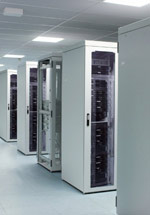Sustainable IT Services
Services for every point in the Sustainable IT
Maturity Curve
Whether your organization is just beginning to formulate Sustainability goals or is well along the path to achieving its sustainability objectives, GreenIT has a service offering to complement your native expertise. We provide design and consulting services and customized education to a wide range of commercial, government, non-profit and educational enterprises.
Services Triangle
GreenIT™ and its affiliates provide clients with consulting assistance for a broad range of activities in Design, Management, and Education.
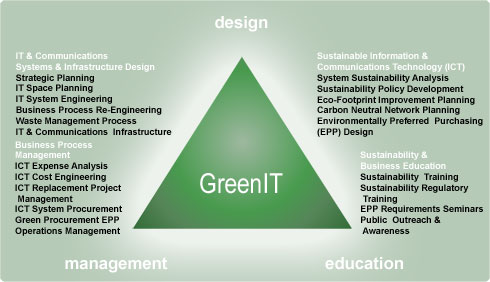
Design
The greatest financial and environmental returns are gained by re-thinking and re-designing existing paradigms and processes. Which organizations will thrive in the fast-changing and environmentally-conscious 21st Century? Achieving the financial and sustainability goals of organizations requires new ideas and bold agendas, not marginal improvement.
Management
The key to success in IT Eco-Efficiency and IT Eco-Innovation is people. New technologies and technical solutions are being delivered faster than most organizations can adapt. Reducing the eco-footprint of IT and harnessing the power of IT to drive sustainability initiatives requires the development of new management and business processes.
Education
Achieving goals for sustainability and financial performance require that everyone involved in an enterprise - Leaders, Employees, Customers, and Suppliers - understand the environmental effects of what they do and how their organization has committed to change. Until recently, little attention has been given to sustainability for IT. As awareness grows and real changes are required, education becomes critical for success.
Core Services
- IT System Design
- IT Infrastructure System Design
- Integrated Facilities Design
- Business Process and System Design
- Eco-Footprint Assessment
- Eco-Innovation Planning and Sustainability Program Project Management
- EPP for IT Systems
- Sustainable IT Education Programs
IT System Design
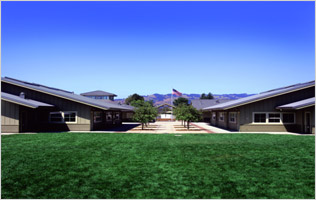 GreenIT provides IT system design solutions that minimize materials used, reduce waste, and improve energy efficiency while reducing TCO and improving performance. Simplification through elimination of unnecessary or overbuilt design elements allows for lower TCO and simplified operations as well as a reduced eco-footprint.
GreenIT provides IT system design solutions that minimize materials used, reduce waste, and improve energy efficiency while reducing TCO and improving performance. Simplification through elimination of unnecessary or overbuilt design elements allows for lower TCO and simplified operations as well as a reduced eco-footprint.
IT Infrastructure System Design
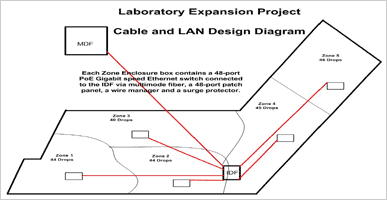 Network cabling systems are the no-man’s land of IT system development --- sometimes the responsibility of IT, sometimes Facilities or Electrical Engineers, and sometimes nobody - until late in the design process. New technologies allow for significant reductions in build costs, operations costs and non-renewable resources used for cable infrastructure; results that can only be achieved through early engagement and collaborative design processes.
Network cabling systems are the no-man’s land of IT system development --- sometimes the responsibility of IT, sometimes Facilities or Electrical Engineers, and sometimes nobody - until late in the design process. New technologies allow for significant reductions in build costs, operations costs and non-renewable resources used for cable infrastructure; results that can only be achieved through early engagement and collaborative design processes.
Integrated Facilities Design
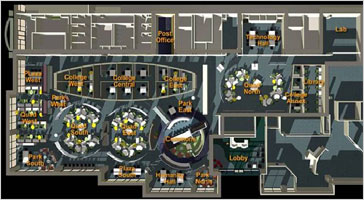 Typically, IT system designers are brought into the process for creating a new workplace just before occupancy – if at all. Integrating IT into the design process from the earliest conceptual stages can produce dramatic benefits for space utilization, facility operating costs, and environmental sustainability. GreenIT projects have demonstrated that office electrical load and IT infrastructure materials can be reduced by 50% or more. When IT systems are properly designed to support alternative workstyle programs, space can be far more adaptable to changing demands over time.
Typically, IT system designers are brought into the process for creating a new workplace just before occupancy – if at all. Integrating IT into the design process from the earliest conceptual stages can produce dramatic benefits for space utilization, facility operating costs, and environmental sustainability. GreenIT projects have demonstrated that office electrical load and IT infrastructure materials can be reduced by 50% or more. When IT systems are properly designed to support alternative workstyle programs, space can be far more adaptable to changing demands over time.
Business Process and System Design
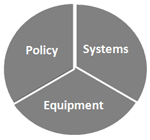 The greatest financial and environmental returns are gained by re-thinking existing paradigms and processes. Which organizations will thrive in the fast-changing and environmentally-conscious 21st Century? Achieving the financial and sustainability goals of organizations requires new ideas and bold agendas, not marginal improvement.
The greatest financial and environmental returns are gained by re-thinking existing paradigms and processes. Which organizations will thrive in the fast-changing and environmentally-conscious 21st Century? Achieving the financial and sustainability goals of organizations requires new ideas and bold agendas, not marginal improvement.
- Double-sided printing can reduce paper consumption up to 40%. A paperless process can speed access to records and reduce costs and environmental impacts for long-term records storage.
- Efficient power supplies and power management can reduce in-use desktop power consumption by 10-30%. Thin-client computing can reduce life-cycle energy consumption by 70-80%.
- Shrinking the size of employee work areas can reduce office building floor space by 10-20%. Creating modern flexible workspaces can eliminate entire buildings.
Eco-Footprint Assessment
 The first step to beginning a sustainable IT program is to determine your current footprint. Only by understanding your present patterns of energy usage and waste creation can you set meaningful goals for improvement. Often, organizational structures and legacy systems make it hard to get an accurate picture of where you are. Using our partner BDNA’s GreenScan and our industry history and knowledge, GreenIT Assessment services help you measure and evaluate your business processes, systems and equipment.
The first step to beginning a sustainable IT program is to determine your current footprint. Only by understanding your present patterns of energy usage and waste creation can you set meaningful goals for improvement. Often, organizational structures and legacy systems make it hard to get an accurate picture of where you are. Using our partner BDNA’s GreenScan and our industry history and knowledge, GreenIT Assessment services help you measure and evaluate your business processes, systems and equipment.
Eco-Innovation Planning & Project Management
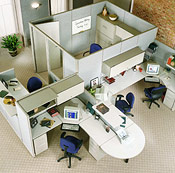 The key to success in IT Eco-Efficiency and IT Eco-Innovation is people. New technical solutions are being delivered faster than most organizations can adapt. Reducing the eco-footprint of IT and harnessing the power of IT to drive sustainability initiatives requires the development of new business processes.
The key to success in IT Eco-Efficiency and IT Eco-Innovation is people. New technical solutions are being delivered faster than most organizations can adapt. Reducing the eco-footprint of IT and harnessing the power of IT to drive sustainability initiatives requires the development of new business processes.
- New technologies can reduce power consumption in data centers by 50-80% and required floor space by 65%. But achieving these results requires integrated planning among IT, Facilities Management, and Real Estate.
- Flexible working, or teleworking, can significantly reduce the demand for office space and employee commute travel. But saving money and reducing environmental impacts require the cooperation of Senior Management, IT, Human Resources, Facilities Management, Real Estate, and Employees.
- Public and private sector procurements are incorporating environmental requirements into IT purchase contracts. That requires Purchasing to work with both IT and environmental specialists to understand what is desirable and possible.
Environmentally Preferable Purchasing (EPP) for IT Systems
 EPP requirements for IT products are being incorporated into major purchasing programs in both the public and private sectors. The EPEAT and Energy Star standards have been widely adopted for government purchases at the Federal, State, and Local government levels. Additional requirements around packaging waste, end-of-life management, Design for Environment and other environmental attributes are appearing as well. GreenIT offers guidance for both the development of RFP requirements and to companies responding to new requirements.
EPP requirements for IT products are being incorporated into major purchasing programs in both the public and private sectors. The EPEAT and Energy Star standards have been widely adopted for government purchases at the Federal, State, and Local government levels. Additional requirements around packaging waste, end-of-life management, Design for Environment and other environmental attributes are appearing as well. GreenIT offers guidance for both the development of RFP requirements and to companies responding to new requirements.
Sustainable IT Educational Programs
 IT product manufacturers are providing educational resources around the environmental benefits of their products, much of it focused on data centers and personal computers. Governments have established environmental requirements and standards for IT. Not-for-profit organizations have developed education campaigns on IT environmental issues. GreenIT offers a broad-based, integrated approach to using those resources and the growing body of scientific research for employee-education programs, workshops, and conferences.
IT product manufacturers are providing educational resources around the environmental benefits of their products, much of it focused on data centers and personal computers. Governments have established environmental requirements and standards for IT. Not-for-profit organizations have developed education campaigns on IT environmental issues. GreenIT offers a broad-based, integrated approach to using those resources and the growing body of scientific research for employee-education programs, workshops, and conferences.


